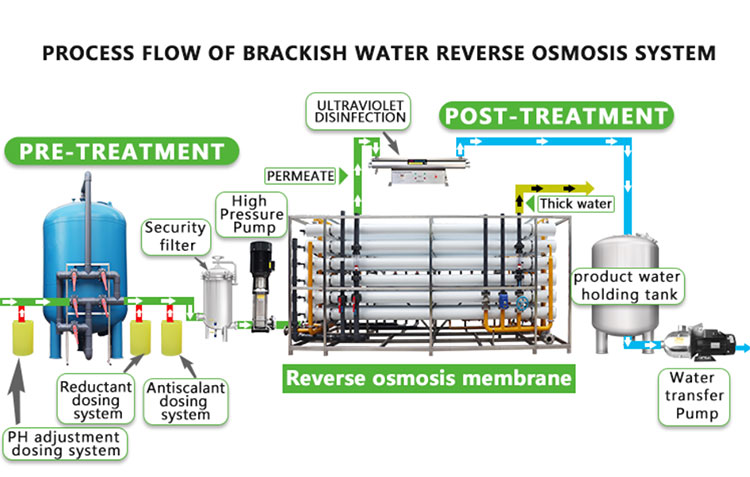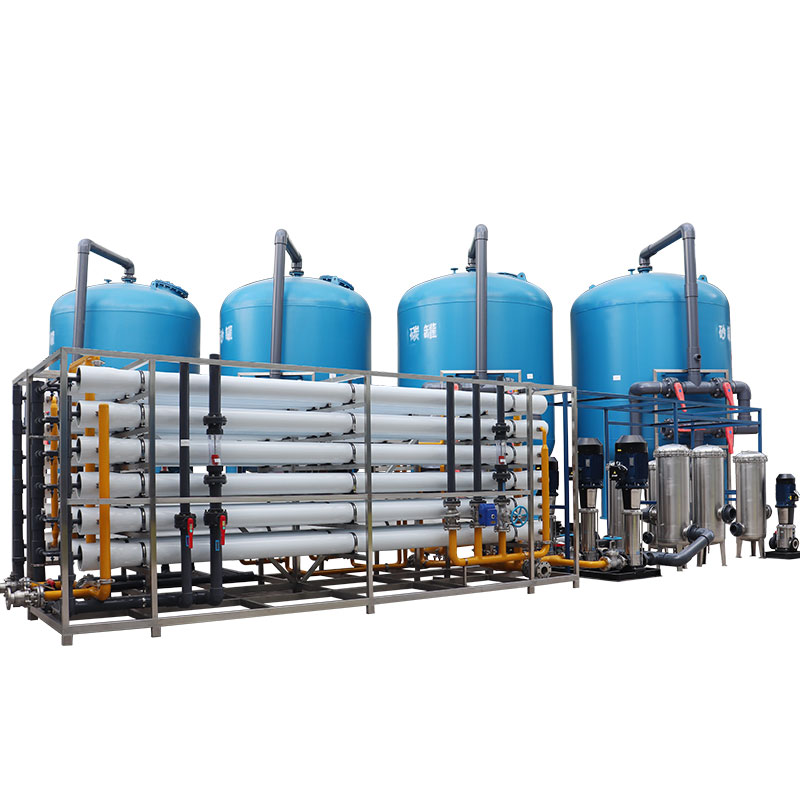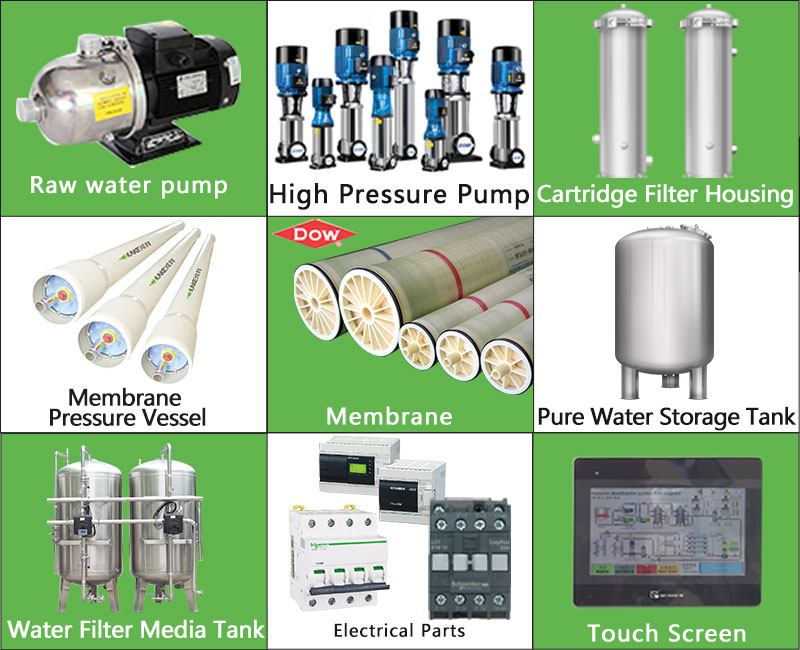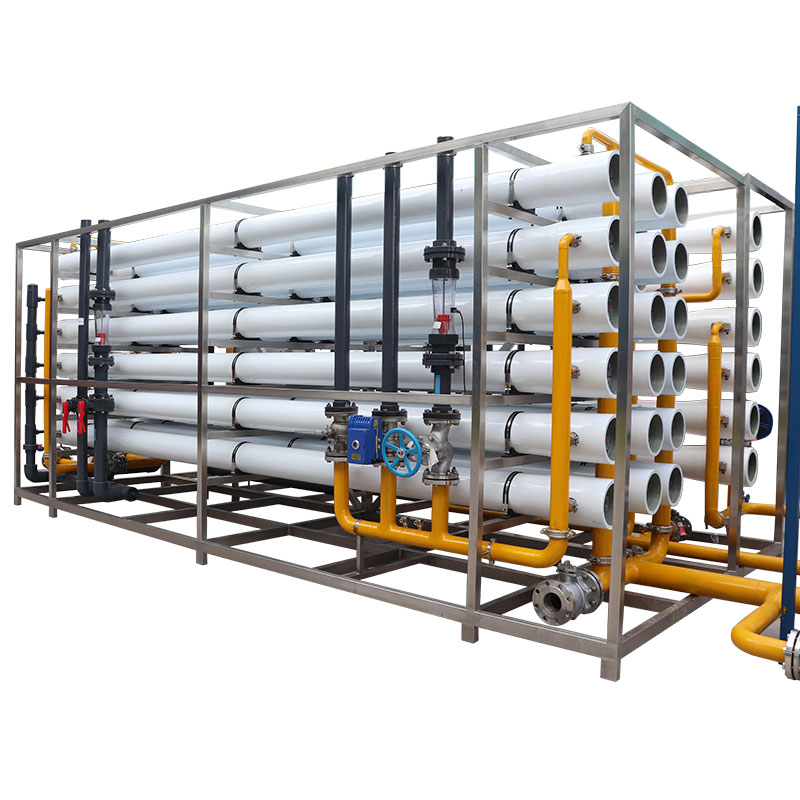How much water does a 30,000 LPH/h RO system consume in one hour?
As a highly efficient water treatment technology, the reverse osmosis (RO) system is widely used in household, industrial and municipal water supply. A 30,000 LPH (liters per hour) reverse osmosis system, which can produce 30,000 liters of pure water per hour, is a typical representative of large-scale industrial and municipal water treatment.
Knowing the amount of water required for such a system to run for one hour is important for evaluating its operating costs and resource consumption. This article will explore this issue in depth and introduce the working principle, practical application and impact of the reverse osmosis system on water resource management.

How does the reverse osmosis system work?
Overview of reverse osmosis technology:
Reverse osmosis technology removes dissolved salts, particulate matter, organic matter and other impurities from water through a semipermeable membrane. Water passes through the semipermeable membrane under high pressure, and pure water passes through the membrane into the water production side, while dissolved salts and impurities are retained on the concentrated water side and discharged with the wastewater. This process can effectively remove most pollutants in the water and produce high-purity drinking water or industrial water.
Composition of reverse osmosis system:
A typical reverse osmosis system mainly consists of the following parts:
● Influent pretreatment system: including coarse filtration, activated carbon filtration and softening treatment, removing large particles, chlorine and hardness ions, and protecting the reverse osmosis membrane.
● High-pressure pump: provides the necessary pressure for water to pass through the reverse osmosis membrane.
● Reverse osmosis membrane assembly: core component, separating impurities in water through semi-permeable membrane.
● Water production pipeline and water storage system: collect and store pure water.
● Concentrated water discharge system: discharge wastewater containing high concentrations of salt and impurities.

What is the operating water consumption of a 30,000 LPH reverse osmosis system?
1. Relationship between water production and water inflow:
The efficiency of a reverse osmosis system is usually expressed in terms of recovery rate, that is, the proportion of water production to water inflow. The recovery rate is affected by many factors such as influent water quality, membrane performance and system design. Generally speaking, the recovery rate of large industrial reverse osmosis systems is between 50% and 75%. For a 30,000 LPH system, assuming a 60% recovery rate, the relationship between the water output and water intake for one hour of operation is as follows:
● Water output (Qp): 30,000 liters per hour
● Recovery rate (R): 60%
● Calculate the recovery rate using the formula: Qin = Qp/R
● Substitute the known values into: Qin = 30,000 liters per hour/60% = 50,000 liters per hour
Therefore, the water intake required for a 30,000 LPH reverse osmosis system to run for one hour is 50,000 liters, of which 30,000 liters of pure water are produced and 20,000 liters of wastewater are discharged.
2. Wastewater treatment and reuse:
The treatment and reuse of concentrated water (wastewater) is an important part of the reverse osmosis system. Directly discharging concentrated water not only wastes water resources, but may also have an impact on the environment. Therefore, many reverse osmosis systems are equipped with wastewater reuse devices to reintroduce part of the wastewater into the water intake system to improve the overall water utilization rate.

Practical application and case analysis of reverse osmosis system
1. Industrial application:
In the industrial field, reverse osmosis systems are widely used in electronics, pharmaceuticals, chemicals and other industries to prepare high-purity water. For example, an electronics factory is equipped with a 30,000 LPH reverse osmosis system, which runs 16 hours a day to meet the water needs of production processes. The system consumes 50,000 liters of influent water and produces 30,000 liters of high-purity water per hour of operation. The concentrated water is reused through the secondary treatment system to further improve the utilization rate of water resources.
2. Municipal water supply:
In municipal water supply, reverse osmosis systems are used to treat groundwater or surface water, remove salt and pollutants, and provide safe drinking water for urban residents. A coastal city used a 30,000 LPH reverse osmosis system to treat the increased salinity of groundwater due to seawater intrusion. The system runs 24 hours a day, treating 720,000 liters of water per day, meeting the drinking water needs of tens of thousands of residents.
3. Emergency water supply:
The application of reverse osmosis systems in emergency water supply is also gradually increasing. When natural disasters or emergencies cause regular water supply interruptions, mobile reverse osmosis units can be quickly deployed to provide drinking water to the disaster area. For example, after the 2010 Haiti earthquake, international rescue teams used mobile reverse osmosis equipment to provide 30,000 liters of fresh water per hour, effectively alleviating the shortage of drinking water in the disaster area.

What is the cost of a 30,000 LPH reverse osmosis system?
1. Initial investment:
The initial investment of a 30,000 LPH reverse osmosis system is relatively large, mainly including equipment purchase costs, installation and commissioning costs, and infrastructure construction costs. Based on market prices, the equipment cost of a system of this scale is about US$200,000 to US$500,000, the installation and commissioning costs are about US$50,000 to US$100,000, and the total investment is between US$250,000 and US$600,000.
2. Operating costs:
The operating costs of the reverse osmosis system include energy consumption, chemical costs, equipment maintenance costs, and labor costs. High-pressure pumps are the main source of energy consumption. The energy consumption of a 30,000 LPH system is about 100 to 200 kWh per hour. Calculated at $0.1/kWh, the energy cost per hour is $10 to $20. In addition, the chemical and maintenance costs per ton of water are about $0.5 to $1. On a comprehensive basis, the system's operating cost per hour is between $40 and $60.
3. Economic benefits:
Despite the high initial investment and operating costs, the reverse osmosis system can bring significant economic benefits in long-term operation. By efficiently utilizing water resources, water costs and environmental pollution are reduced, while the water safety of production and life is improved. For industrial enterprises and municipal water supply departments, the application of reverse osmosis systems not only saves water resources, but also improves economic and social benefits.
Conclusion
As an efficient water treatment technology, the 30,000 LPH reverse osmosis system can consume 50,000 liters of influent water in 1 hour and produce 30,000 liters of pure water, providing reliable protection for industrial production, municipal water supply and emergency rescue.
Despite the high initial investment and operating costs, the economic and social benefits in the long run are significant. Through continuous technological innovation and policy support, the reverse osmosis system will play a more important role in the future, providing a solid guarantee for global water resource management and sustainable development.




